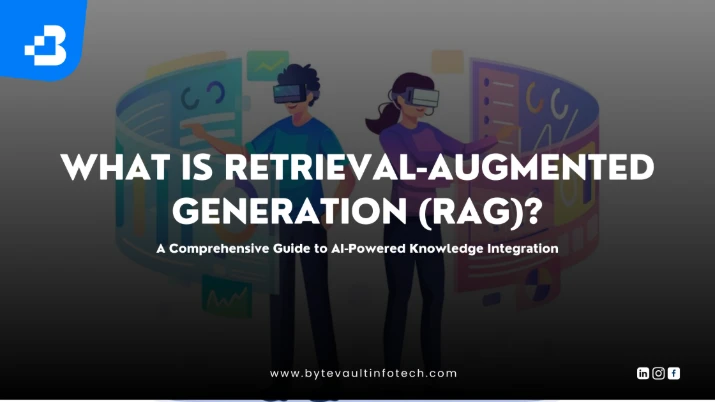Stay Updated with Our Latest Insights
Stay ahead with our latest updates, expert opinions, and in-depth articles on cutting-edge technology, software development, and digital innovation.
Retrieval-Augmented Generation (RAG) is a relatively new framework that has gained a lot of attention in the natural language processing (NLP) community. It combines two powerful techniques - Large Language Models (LLMs) and Information Retrieval (IR) systems - to improve the quality and relevance of generated text.

Did you know that 72% of AI experts believe integrating real-time data retrieval is critical for next-gen AI systems? Yet, large language models (LLMs) like ChatGPT often struggle with outdated or generic responses. Retrieval-Augmented Generation (RAG) solves this by merging real-time data retrieval with AI’s generative power.
In this guide, you’ll learn:
How RAG bridges the gap between static LLMs and dynamic knowledge.
Step-by-step breakdown of RAG’s architecture.
Real-world applications across industries.
Practical steps to implement RAG.
Retrieval-Augmented Generation (RAG) combines two critical phases: retrieval and generation. Here’s a simplified breakdown:
When a user inputs a query (e.g., "Explain quantum computing"), RAG searches a connected database (like company documents or research papers) to fetch relevant, up-to-date information.
The retrieved data is fed into a Large Language Model (LLM), which synthesizes the external knowledge with its pre-trained understanding to generate a context-rich, accurate response.
Example: If you ask a RAG-powered chatbot, "What’s Salesforce’s return policy?" it first retrieves the latest policy documents from Salesforce’s database, then generates a summary using GPT-4 or similar models.
RAG addresses critical limitations of traditional LLMs like ChatGPT. Key benefits include:
By grounding responses in retrieved facts, RAG minimizes AI "make-believe."
No need to retrain massive models—simply update the database.
Easily customize AI for industries like healthcare (e.g., pulling latest drug research) or finance (real-time market reports).
Users can trace answers back to source documents (e.g., "According to our 2025 policy guide...").
Use Case: A bank using RAG can deploy a customer service bot that always references the latest interest rates and regulations.
The retriever scans external datasets (e.g., PDFs, databases, APIs) to find contextually relevant information. Tools like Google’s Vertex AI use vector search to match user queries with data.
Example:
User asks, “What’s the latest NVIDIA GPU release?”
→ RAG retrieves NVIDIA’s 2024 press releases.
The retrieved data is formatted and fed into the LLM as context. AWS’s RAG solution uses Amazon Kendra to rank and filter results.
The LLM generates a response using both its pre-trained knowledge and the retrieved data.

RAG reduces “hallucinations” by grounding responses in verified data. Salesforce reported a 40% increase in customer satisfaction after integrating RAG into their chatbots.
No need to retrain models—update your database instead.
Easily adapt to new domains (e.g., healthcare, legal) by updating the retrieval corpus.
While both RAG and fine-tuning enhance LLMs, they solve different problems:
| RAG | Fine-Tuning |
|---|---|
| Pulls external data during inference | Trains the model on new data |
| Ideal for dynamic, real-time data (e.g., FAQs, policies) | Best for mastering static tasks (e.g., legal contract analysis) |
| Lower cost, faster implementation | Requires heavy computational resources |
When to Choose RAG: Opt for RAG if your use case requires accessing frequently updated information (e.g., customer support, medical diagnostics).
Data Dependency: Garbage in, garbage out! If your database is outdated or unorganized, RAG will underperform.
Latency: Retrieving data adds milliseconds to response times—problematic for real-time apps like stock trading.
Complex Integration: Aligning retrieval systems (e.g., Elasticsearch) with LLMs requires technical expertise.
💡 Pro Tip: Pair RAG with vector databases like Pinecone for faster, semantic search.
Healthcare: Example: IBM’s Watson Health uses RAG to pull the latest clinical trial data when doctors ask about treatment options.
E-commerce: Example: Amazon’s customer service bot retrieves real-time delivery statuses and return policies.
Legal Tech: Example: Startups like Casetext apply RAG to fetch relevant case laws for lawyers drafting arguments.
These examples show how RAG bridges the gap between static AI knowledge and real-world dynamism.

RAG stands for Retrieval-Augmented Generation, a framework that combines Large Language Models (LLMs) and Information Retrieval (IR) systems to improve the quality and relevance of generated text.
RAG uses LLMs to generate text and IR systems to retrieve relevant information in real-time and incorporate it into the generated text, making it more accurate and informative.
LLMs are pre-trained neural language models that are highly knowledgeable in understanding and generating human language. IR systems are used to retrieve relevant documents or passages from a large corpus based on a given query.
RAG can handle out-of-domain or rare queries, as well as complex queries, making it more accurate and relevant in generating text. It has also shown promising results in various NLP tasks, such as question-answering and chatbot performance.
The computational cost of combining LLMs and IR systems in real-time can be a challenge, making it difficult to scale for certain applications. Other limitations include the need for a large corpus and potential bias in the retrieved information.
Experts predict RAG will dominate enterprise AI by 2025. Innovations include multi-modal retrieval (text + images) and self-improving models.
Stay ahead with our latest updates, expert opinions, and in-depth articles on cutting-edge technology, software development, and digital innovation.